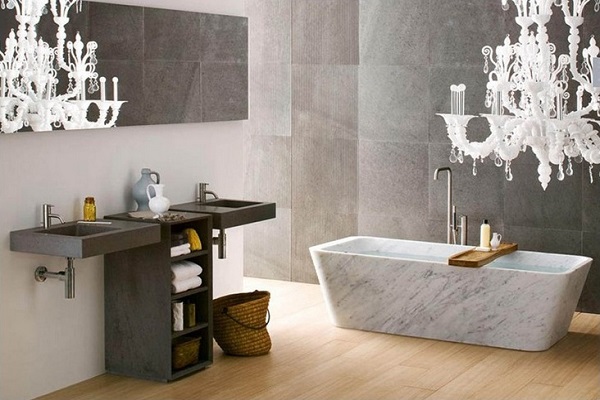AS A MATERIAL THAT HAS BEEN TRUSTED IMPLICITLY FOR THOUSANDS OF YEARS, MARBLE DESIGNS ARE EXTREMELY RICH AND DIVERSE.
Marble has been used for centuries, both for sculpting as well as for construction. Ancient Greece and Rome are well-known for their use of marble, especially as a sculpting medium and in their classical architecture. Marble has become a symbol of refinement and taste. But what is it?
Marble, the “non-foliated metamorphic rock composed of recrystallized carbonate minerals,” is nothing more than a “hipster” limestone that decided it wanted to be more original. The word marble originates from the Greek word, marmaros, which means “a snow white and spotless stone.”

Though marble is known for its pure white color, it comes in many different shades and unique patterns. The stone can range from the whitest of whites to the blackest of blacks, and everything in between including pink, yellow, green, red, brown, and other color variations.
Marble’s individuality is due to impurities caused by clay, sand, and silt. Impurities are added to the stone due to the intense heat and pressure during metamorphism. These impurities are layered in the limestone, creating a variety of individualistic designs.
Think of a hipster layering on clothing in order to look original, or that one kid in your high school who found themselves every year and always had a new style. One minute they’re a geek that can tell you just about anything you would like to know; the next minute their only concern is what shade of Maybelline lipstick they want to wear.
A Brief History Lesson
Throughout history, marble has proven very useful. Marble composed the building blocks for Trajan’s Column, symbolic of the Roman triumph in the Dacian Wars. It has been used for monolithic columns that have supported grand structures for centuries.
Greece is known for its architecture, sculpture, and brilliant stone cutting. The ancient Greeks imported marble to build their monuments and temples as it was considered to be a beautiful treasure – or because of a slight addiction. With marble, they built the Temple of Artemis, which was one of the seven wonders of the ancient world. What big columns this temple had?
What height this five story temple had? All the better to destroy? I am guessing so because this temple was destroyed by the Goths, an East Germanic tribe. Had it not been deliberately attacked, it would most likely still be intact today.
The territories around ancient Greece contained abundant supplies of fine marble. Pentelic and Parian marble were the most prized sources of marble. Pentelic marble was, and is, obtained from Mount Pentelicus, a mountain range in Attica, Greece located northeast of Athens and southwest of Marathon.
Its marble was used to build the Acropolis in Greece; which is basically what happens when humans get the bright idea to build a city on top of a huge hill. Pentelic marble is pure white with a uniform yellow tint. Under sunlight, this tint makes it shine with a golden hue.
Parian marble is a fine-grained semi-translucent pure white entirely flawless marble. It was used to build the Nike of Samothrace and other sculptures such as the Medici Venus as well as Napoleon’s tomb. Other famous sculptures and architecture made from marble include the Taj Mahal in India, Bartolini’s La Table aux Amours ca. 1845, and Gould’s The West Wind ca. 1876.
The list of marble’s utility in the ancient world goes on and on. But what was once the chosen material to embody Roman gods and goddesses can now be found in a typical American home.
Incorporating Marble in Modern Design
As you can see, marble has a rich history, which continues to this day. This constructive design material is still popular and will be for many, many years to come. That being said, I decided to include some of my favorite uses of marble in modern design. I am also going to tell you how the inclusion of marble can change the look of any space — enjoy!
Here the designer is using a beautiful, bright marble with deep gray and golden brown highlights. The comeliness of the marble adds to the mystique of the overall design. The marble’s pattern is more intense in the upper left portion below the shelf, which creates a relationship with the dark brown bottles.
This helps to direct the eyes from the marble’s design to the square photo to the colorful design accessories on the right. We can see the transition from dark to light that is created by the marble itself.
Marble cutting boards can add a nice touch to your kitchen. Marble is hard and very sturdy, which makes it a great material to use for a cutting board. Wooden cutting boards often collect scratches, and food can collect in these imperfections.
Marble, on the other hand, is easy to clean and scratches that are produced only add to the overall appeal. Kitchen designs that incorporate white marble are refreshing and not only brighten the room, but the moods in it.
Using white marble with light gray and brown highlights adds an interesting dimension in the bathroom. I enjoy minimalistic designs that incorporate marble because they allow the marble to take the lead. Light reflects off walls that are lightly colored making a room seem brighter and more open.

In the bathroom above, the natural light bounces off the walls and completely illuminates the room. The bathroom appears brighter and gives off a positive vibe. I truly enjoy bathroom designs that focus on marble because they are fresh, clean, and a joy to view.
Thanks for reading—we would love it if you shared this post with friends and family! What are some of your favorite designs—old and new—that incorporate marble? Comment and let us know!